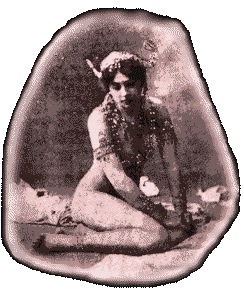MATA HARI
 She was born Margaretha Geertruida Zelle in Leewarden,
Holland on
August 7th, 1876, and she knew diddly
about the technicalities of dance. What she did
have, however, were striking good looks,
a very clever mind, and a whole lot of chutzpah.
To get away from her morose, bankrupt,
widowed father, a teenaged Mata answered a
prank classified ad put in by the buddies
of a Colonial Army Officer stationed in the
Dutch East Indies. She wound up marrying
Captain Rudolph Macleod, and they settled in
East Java where they had 2 children.
But after an 'incident' on Macleod's part
(the rape of a servant's daughter) caused the
retaliatory poisoning death of their son,
they returned to Holland, where Macleod
descended into alcoholism and flagrant
womanizing. Mata was granted a divorce on the
grounds of maltreatment, left her daughter
with relatives, and set off for Paris.
She had no money and no skills, and tried
to make it as an artist's model before drawing
upon her observations of Javanese dancers
and her memento collection of bangles and
bracelets to invent the mythical Oriental
dancer, 'Mata Hari'. The fact that she was
gorgeous made the rest a snap.
During the early years before World War
I, Mata danced her way into the hearts and
wallets of soldiers and statesmen on all
sides of the political map and all over the globe.
When she returned to Paris in 1915, she
took on the persona of a wealthy woman of
fashion, denying the Indian origins, and
claiming various nationalities, including German.
The Allies deported her to Holland when,
despite constant surveillance, they were unable
to track her movements. There were several
(failed) operations mounted to catch her in
the act, but no hard evidence could be
found of her espionage activity. Eventually, she
was set up by French Intelligence, trapped,
and imprisoned. Spy phobia was rampant, and
the government set out to make an example
of her.
At her trial, much was made of her numerous
liasons with German officers. Her calm
response was that she kept company with
soldiers as a matter of sexual preference -
"...men who are not in the army do not
interest me at all...an officer, in my eyes, is a
superior being - a man who is always ready
for any adventure, or for any danger, but
when I loved it was always soldiers, and
it did not matter to me what country they came
from..."
Although most of the evidence at her trial
seems, on historical retrospect, to have been
either trivially circumstancial, grossly
overdramatized, or outrightly manufactured, there is
no denying that the thing that actually
got her arrested was her use of a secret German
spy number (known to French Intelligence)
to identify herself in a courier transaction.
What was not publicized was that the Germans
knew that the French knew, and had
obviously set Mata up.
The French could not afford to let her
go, and where they were once titillated by her
'affaires d'amour', they now used the
nails of 'immorality' to crucify her. The Germans
could not afford to have the world find
out how much crucial information was in Mata's
head due to her high-level bedhopping,
and were happy to see her nailed.
That she was vilified for being a harlot
("Harlot, yes!" she cried in court, "but traitoress,
never!") shows that she overestimated
the tolerance of her times. But was she spying for
the Germans, or the French? We suspect,
clever opportunist that she was, that she had
simply burned too many candles at both
ends, and was in turn consumed...
A large Paris crowd gathered on the morning
of October 15th, 1917. Dressed simply and
elegantly, Mata Hari refused both blindfold
and tether, and blew a kiss to the firing squad
before they pulled the trigger. It is
reported that one of the soldiers was so overcome by
emotion at the thought that his rifle
had held the fatal bullet, that he fainted after firing.
She was born Margaretha Geertruida Zelle in Leewarden,
Holland on
August 7th, 1876, and she knew diddly
about the technicalities of dance. What she did
have, however, were striking good looks,
a very clever mind, and a whole lot of chutzpah.
To get away from her morose, bankrupt,
widowed father, a teenaged Mata answered a
prank classified ad put in by the buddies
of a Colonial Army Officer stationed in the
Dutch East Indies. She wound up marrying
Captain Rudolph Macleod, and they settled in
East Java where they had 2 children.
But after an 'incident' on Macleod's part
(the rape of a servant's daughter) caused the
retaliatory poisoning death of their son,
they returned to Holland, where Macleod
descended into alcoholism and flagrant
womanizing. Mata was granted a divorce on the
grounds of maltreatment, left her daughter
with relatives, and set off for Paris.
She had no money and no skills, and tried
to make it as an artist's model before drawing
upon her observations of Javanese dancers
and her memento collection of bangles and
bracelets to invent the mythical Oriental
dancer, 'Mata Hari'. The fact that she was
gorgeous made the rest a snap.
During the early years before World War
I, Mata danced her way into the hearts and
wallets of soldiers and statesmen on all
sides of the political map and all over the globe.
When she returned to Paris in 1915, she
took on the persona of a wealthy woman of
fashion, denying the Indian origins, and
claiming various nationalities, including German.
The Allies deported her to Holland when,
despite constant surveillance, they were unable
to track her movements. There were several
(failed) operations mounted to catch her in
the act, but no hard evidence could be
found of her espionage activity. Eventually, she
was set up by French Intelligence, trapped,
and imprisoned. Spy phobia was rampant, and
the government set out to make an example
of her.
At her trial, much was made of her numerous
liasons with German officers. Her calm
response was that she kept company with
soldiers as a matter of sexual preference -
"...men who are not in the army do not
interest me at all...an officer, in my eyes, is a
superior being - a man who is always ready
for any adventure, or for any danger, but
when I loved it was always soldiers, and
it did not matter to me what country they came
from..."
Although most of the evidence at her trial
seems, on historical retrospect, to have been
either trivially circumstancial, grossly
overdramatized, or outrightly manufactured, there is
no denying that the thing that actually
got her arrested was her use of a secret German
spy number (known to French Intelligence)
to identify herself in a courier transaction.
What was not publicized was that the Germans
knew that the French knew, and had
obviously set Mata up.
The French could not afford to let her
go, and where they were once titillated by her
'affaires d'amour', they now used the
nails of 'immorality' to crucify her. The Germans
could not afford to have the world find
out how much crucial information was in Mata's
head due to her high-level bedhopping,
and were happy to see her nailed.
That she was vilified for being a harlot
("Harlot, yes!" she cried in court, "but traitoress,
never!") shows that she overestimated
the tolerance of her times. But was she spying for
the Germans, or the French? We suspect,
clever opportunist that she was, that she had
simply burned too many candles at both
ends, and was in turn consumed...
A large Paris crowd gathered on the morning
of October 15th, 1917. Dressed simply and
elegantly, Mata Hari refused both blindfold
and tether, and blew a kiss to the firing squad
before they pulled the trigger. It is
reported that one of the soldiers was so overcome by
emotion at the thought that his rifle
had held the fatal bullet, that he fainted after firing.

Another account...
Mata Hari was reincarcerated to await
her execution in a cell at Saint-Lazare prison,
where upon her request she had delivered
to her a book outlining the teachings of
Buddhism. She lived out her final days
in meditation and contemplation of philosophies on
the nothingness of life, joyful renunciation
and the happiness of nirvana. On the morning
of her execution she told Sister Leonide
who had visited her daily for the last 5 months, "
Don't fear Sister, I shall know how to
die without weakness ". A crowd had gathered for
the dawn execution at the barracks square
in Vincennes where Mata Hari, dressed
simply but elegantly was promptly ushered
into position. A single trumpet call resounded
as she stood, refusing to be tethered
or blindfolded against a post at the end of the square.
A dozen riflemen made up the firing party.
Her final request before blowing a kiss to the
soldiers was " Don't shoot at my face.
Aim for my heart!"
As the shots rang out and her slain body
slumped to the ground, another body also fell.
One of the young privates in the firing
squad had fainted with trauma. No-one from the
dawn crowd came forward to claim her body,
not one of her family or the many that had
once loved and admired her. Medical students
finally dissected her body.
HOME


